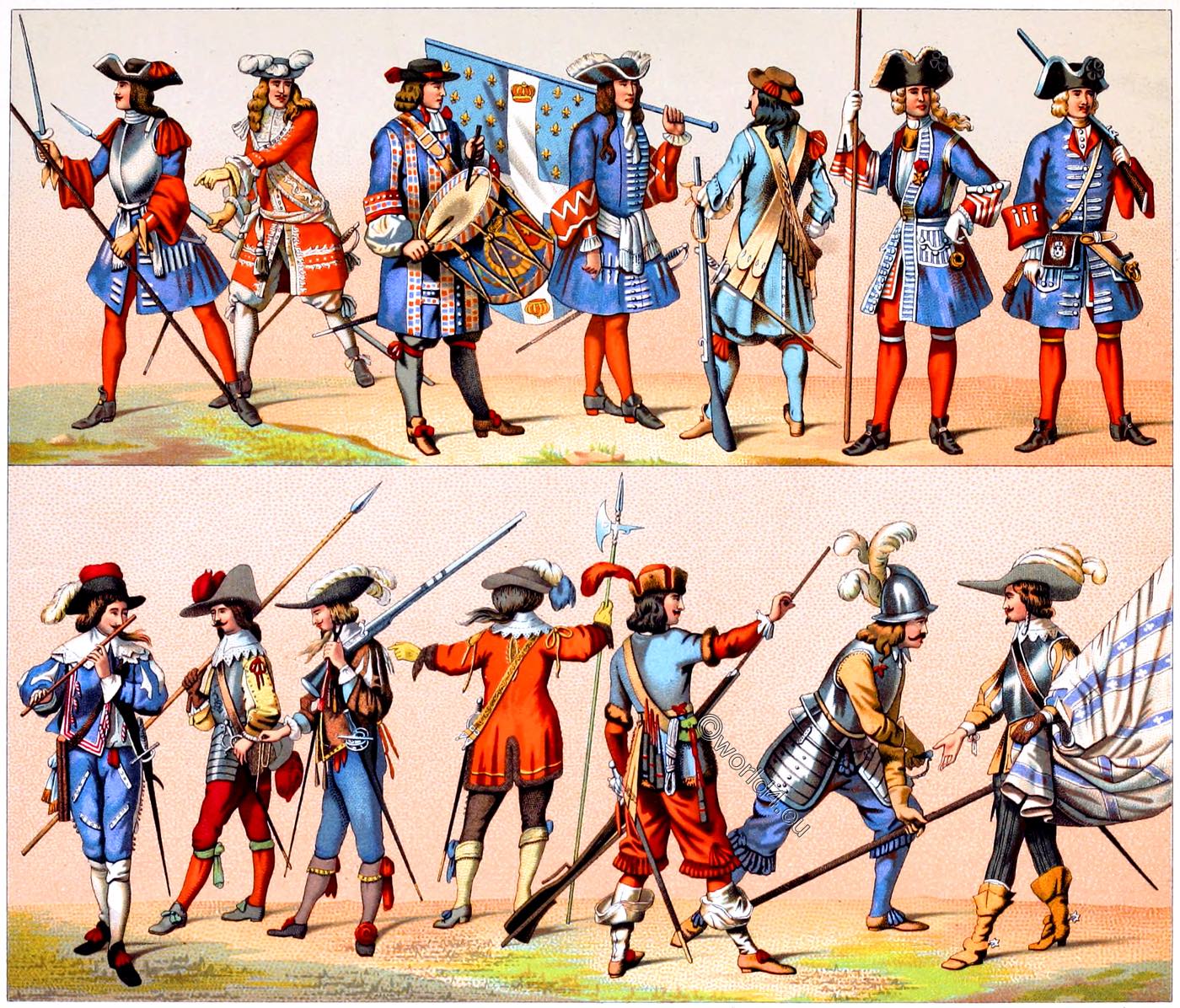FRANCE. XVII. XVIII. CENTURY. COSTUMES OF SOLDIERS.
THE FRENCH GUARDS SINCE THEIR FOUNDATION. GOVERNMENT OF LOUIS XIII., LOUIS XIV. AND LOUIS XV.

The formation of the French Guards dates back to 1563; Charles IX (1550-1574) abolished them and Henry III (1551-1589) reintroduced them when he ascended the throne.
- No. 1 – Pikiner (1697). – Hat with bow and open brim; breastplate; trousers and stockings of the same colour as the lapel; 14 foot long pike and epee. The pikemen stood against the cavalry in first and against the infantry in second line.
- No. 2 – Officer (1664). – Scarlet skirt with embroidery; silver sash; bandelier; puff trousers. Officers and NCOs wore the spontaneous. A Sponton sometimes also known as an epontoon or half-pike, is a half-pike and was also regarded as a badge of rank for infantry officers. Spontaneous was widespread in the mid-seventeenth century and continued to be used until the middle of the late nineteenth century.
- No. 3 – Tambour (1664). – Surcoat in the colour of the king; Turkish blue with blue, white and red carreaus.
- No. 4 – Flag bearer (1697) with the company flag. (Blue with golden lilies; white cross with golden crown in each arm.
- No. 5 – Musketeer (1664). – Compagnie Maulpeon: Grey-blue uniform; red ribbons on hat, right shoulder and puff trousers; epee and cartridge ribbon.
- No. 6 – Officer (1724). – Opened hat with black cockade and golden galloons; surcoat in the colours of the king: blue and red; trousers and stockings in the colours of the lapels; spontoon (half-pike).
- No. 7 – Soldier (1724). – Tricorned; surcoat with broad laps; belt with patron pocket, epee pendant and bayonet pocket; powder horn and ball pocket on the bandelier.
- No. 8 – Whistler (1630). – Since the reign of Francis I, there have been whistlers in all companies. Feathered hat; doublet in the colours of the king; tight breeches.
- No. 9 – Pikiner (1630). – Feathered hat; turned-up collar; breastplate; underarm cords; ribbons on the leg in the captain’s colours; thick gloves; a second hat to change, hanging at the side.
- No. 10 – Musketeer (1630). – Doublet with slit sleeves; musket with fuse and musket fork.
- No. 11 – Sergeant (1630). – Fur-trimmed skirt. Open at the front with long laps, since Louis XIII. introduced as hongreline in the army; halberd.
- No. 12 – Musketeer (1647); Compagnie Hantefeuille. – Woolen hat; fur-trimmed doublet; red puffed trousers; fold over boots; bandelier; belt with military pendant.
- No 13 – Pikiner (1647). – Helmet with feather bush; Buff coat (Jerkir) under the breastplate; hip covers.
- No. 14 – Flag bearer (1630). – Feather hat; Buff coat with slit sleeves; breastplate; bandelier; spur boots. The flags of the regiment were not yet identical. Apart from the flag of the colonel, each company carried one in the colours of its captain.
One cannot speak of a uniform before Louis XIII. Every soldier dressed as he could and wanted to. Under Louis XIII, the guards were no different from the other infantry regiments, except that the officers, cadets and some of the soldiers wore spur boots as a sign of their nobility. The Guard Regiment, sometimes 12, sometimes 20 companies strong, consisted of pikemen, arquebusiers and musketeers.
Louis XIV had thirty companies of French guards and two grenadier companies formed in 1689. The number of men in the company changed. In 1664 the French guards wore uniform, but the orderly dress differed according to the companies. In 1691 the uniform of the guards was changed to dark blue. The flags of the order were blue, with golden lilies and a white cross with a golden crown at the end of each arm.
After the Peace of Ryswik (1697) the hat with open brim, gold galloon garnishing and cockade is used. The pikes disappear.
Louis XIV formed a third grenadier company, so that the regiment’s total number was 4530 men with 218 officers in 6 battalions. The uniform remained blue with red lapels and white gallons. The rank of the guard officers was one level higher than the other infantry officers.
Images after simultaneous engravings and drawings.
Compare de Marbot und de Noirmont, les Costumes militaires en France. – Susane, Histoire de l’infanterie française. – Quicherat, Histoire du costume en France.
Source: History of the costume in chronological development by Auguste Racinet. Edited by Adolf Rosenberg. Berlin 1888.
Related
Discover more from World4 Costume Culture History
Subscribe to get the latest posts sent to your email.






